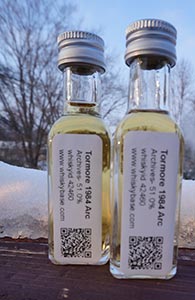
This is my first Tormore ever. I know that it is in the Speyside, that its malt largely goes into the blends in owners Pernod-Ricard’s portfolio and that it doesn’t have much of a reputation–and that is pretty much it. Therefore, I will not be able to tell you if this bottling–in Whiskybase’s Archives series–is representative or an outlier.
Tormore 29, 1984 (51%; Archives, “Fishes of Samoa”; Barrel No. 3669; from a purchased sample)
Nose: Malty, slightly grassy sweetness. A touch of lime below that which expands along with the maltiness; some salt too now. After a minute or two the lime is ascendant and is rather nice–mellow, not terribly acidic. With a lot more time the lime fades some and there’s some indistinct fruity sweetness now. With a drop or three of water there’s an expanding butteriness (with a little bit of vanilla).
Palate: Starts out sweeter than on the nose with some floral hints but there’s the lime–more intense than on the nose. More fruit here too as I swallow; the lime gives way to peaches first and then it turns a touch tropical with some tinned pineapple and just a hint of tart mango. Nice, thick mouthfeel. Gets spicier as it goes. Water pulls out more of the spice and pairs it with the acid from the citrus. The fruit does recede some.
Finish: Long. It is here that the oak makes its presence felt as the fruit fades out–toasted wood, a little spicy. More sweetness with water.
Comments: The nose led me to think that this would be a middling malt but it explodes on the palate. The finish is a little weak again. Pass on water, I think. Okay, must try more Tormore. Anyone have any recommendations? This is still available, by the way, but I can’t decide if I want a full bottle.
Rating: 88 points.

I had the OB 10yo. I was not impressed, simple, metallic, one of the weaker single malts I’ve had.
LikeLike
I am such an expert that I did not even know there was an OB 10.
LikeLike
It’s rich’s favorite
LikeLike
I meant the 12yo OB, sorry.
LikeLike
Oh look, there are a couple of new OB Tormores coming out. Suspiciously orange, I have to say.
LikeLike
Impeccable timing, Mao!
The two new ones look interesting – though maybe not for the price. The 16yo is not chill-filtered (and non-coincidentally, at 48%), whereas the 14yo is probably chill-filtered (and 43%). That’s a unique approach, afaik, as if saying we have something for the geek and something for the newbie too. Also, flaunting age, them being Pernot-Ricard. In your face, Diageo, in your face, Macallan! “American oak” could include ex-sherry, so I don’t exclude natural color, but my hopes are low. Kinda waste, if you ask me, to boast non-chill-filtering but then pump it up with caramel. They use the word “orange” in the taste descriptor so that’s always a red flag (“It has to taste orange, more caramel, it still looks like it it tastes lemon!”) We’ll see… I’d be up for a bottle share when it arrives. Given my previous Tormore experience I surely won’t be disappointed.
LikeLike
American oak casks could indeed be ex-sherry, as most sherry casks are made of American oak. But my understanding is that sherry casks that contribute rich colour to young or middle-aged whiskies get that colour from European oak, not from the sherry itself (and that these are ex-transportation/temporary storage casks, not casks that matured sherry). So, if a distillery doesn’t talk about European oak casks odds are very high that they’re using ex-bourbon American oak. 14-16 years in first fill ex-bourbon casks could still impart a fair bit of colour, but, f they don’t mention natural colour on their website while specifying NCF then it’s probably coloured.
LikeLike
OK, thanks for the explanation. I probably read this business of American vs. European oak 13 times in various places in the past, but it always made my head spin. The key point that I was missing is that the color is not from the sherry but from the wood itself. So a whisky aged in an ex-Chablis, European oak cask would also get a dark tint – am I getting that right?
You may not know your Tormore, but you’re becoming quite the expert in cask aging, Mr. GlenDronach!
LikeLike
I don’t know about “expert”, this is all stuff I’ve cobbled together from people who know far more than me–folks on the W3 forum, my friend Rich.
As for white wine casks and dark colour, I’d expect so, assuming they’re consistently made of European oak. And indeed if you go back and look at my write-up of the Glen Moray Chardonnay Cask (which I quite liked) you’ll see I speculated then that its much darker hue, compared to the regular 12 yo, must be from caramel; but that could just as well be from a European oak cask. (Though if it were from European chardonnay wouldn’t it be more likely to be called a Chablis cask?)
LikeLike
I recently purchased a bottle of the Tormore 13 (Gordon & MacPhail – Discovery), in part because I spotted it at a nearby (and quite mediocre) liquor store that doesn’t tend to venture beyond the recognizable and mainstream (it leans overwhelmingly toward Glenmorangies and Glenlivets). So I was surprised to see it on the shelf and decided to take a chance. At $78, including South Carolina’s hefty tax, I was relieved: it’s a pleasant and very fruity whisky, with the elegance and freshness of a Speyside. Perhaps a bit a wee bit pricey for a 13 year-old, but it’s unlikely I’ll ever come across a Tormore around these parts anytime soon.
LikeLike